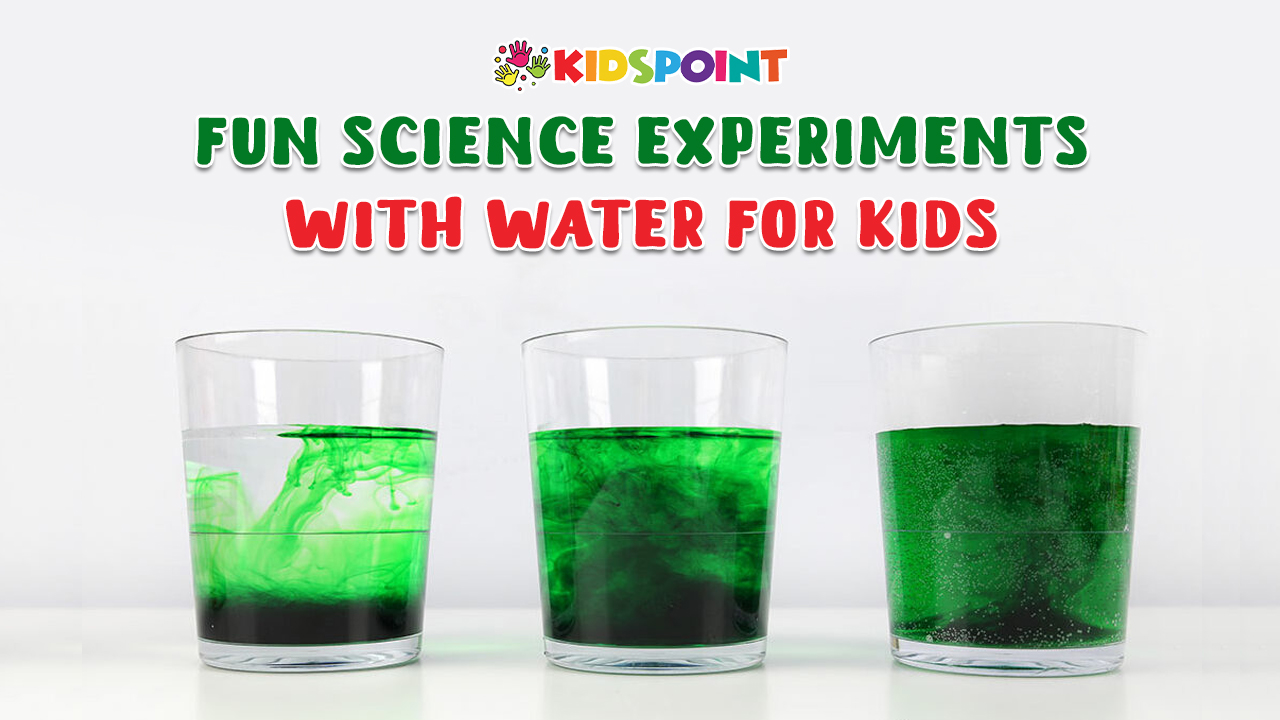Water is a fascinating substance that offers endless opportunities for exploration and experimentation, especially for kids. Engaging in science experiments with water not only entertains children but also teaches them valuable scientific concepts in an interactive and hands-on way. At The Kids Point, we believe in fostering curiosity and learning through fun activities. Let’s dive into some exciting science experiments with water that kids can enjoy:
The Magic of Surface Tension:
Experiment: Floating Paperclip
Materials Needed
- A bowl of water
- Paperclip
Procedure
- Fill a bowl with water.
- Carefully place a paperclip on the surface of the water.
Explanation
This experiment demonstrates the concept of surface tension. Water molecules are attracted to each other, creating a thin layer on the surface that can support lightweight objects like the paperclip. It showcases how water molecules stick together, forming a kind of “skin” on the surface.
The Power of Absorption
Experiment: Absorbency Test
Materials Needed
- Several types of paper (tissue paper, paper towel, construction paper)
- Water
- Dropper or small cup
Procedure
- Cut small squares of different types of paper.
- Place them on a flat surface.
- Use a dropper or small cup to drop water onto each piece of paper and observe what happens.
Explanation
This experiment helps kids understand the concept of absorption. Different types of paper have varying levels of absorbency based on their composition. Through this experiment, kids can observe how water is absorbed differently by different types of paper.
Exploring Density
Experiment: Layered Liquids
Materials Needed
- Clear glass or container
- Water
- Corn syrup
- Vegetable oil
- Food coloring (optional)
Procedure
- Fill the glass or container about 1/3 full with water.
- Slowly pour corn syrup into the container, being careful not to mix it with the water.
- Lastly, pour vegetable oil into the container.
- Optional: Add a drop of food coloring to each layer to make it more visually appealing.
Explanation
This experiment demonstrates the concept of density. Liquids have different densities, causing them to layer based on their weight per unit volume. Kids can observe how the liquids form distinct layers due to their varying densities, with the most dense liquid (corn syrup) at the bottom and the least dense liquid (vegetable oil) at the top.
The Science of Evaporation
Experiment: Evaporation Race
Materials Needed
- Small containers or dishes
- Water
- Stopwatch or timer
Procedure
- Fill each container with the same amount of water.
- Place the containers in different locations, such as indoors and outdoors or in areas with varying temperatures.
- Use a stopwatch or timer to track how long it takes for the water to evaporate from each container.
Explanation
This experiment allows kids to observe the process of evaporation and understand how it is influenced by factors such as temperature and humidity. They can compare the rate of evaporation in different environments and learn how heat energy causes water molecules to escape into the air.
The Mystery of Floating and Sinking
Experiment: Sink or Float
Materials Needed
- Various small objects (e.g., coins, buttons, small toys)
- Water
- Container or bowl
Procedure
- Fill a container or bowl with water.
- Have kids predict whether each object will sink or float.
- Place each object in the water and observe what happens.
Explanation
This classic experiment teaches kids about buoyancy and density. Objects that are less dense than water will float, while those that are denser will sink. By testing different objects, kids can learn to make predictions based on their understanding of buoyancy and observe how the concept applies in real life.
The Art of Water Movement
Experiment: Capillary Action
Materials Needed
- White flowers with stems (e.g., carnations)
- Food coloring
- Water
- Clear containers or glasses
Procedure
- Fill the containers with water.
- Add different colors of food coloring to each container.
- Trim the stems of the flowers and place them in the colored water.
- Observe how the flowers change color over time.
Explanation
This experiment demonstrates capillary action, the process by which water moves through narrow spaces, such as the stems of plants. Kids can observe how water and dissolved nutrients travel up the stem of the flower, causing it to change color. It provides a visual representation of how water moves in plants and how capillary action contributes to this process.
Harnessing the Power of Air Pressure
Experiment: Cartesian Diver
Materials Needed
- Plastic bottle with cap
- Water
- Small plastic dropper or pipette
- Modeling clay or plasticine
Procedure
- Fill the plastic bottle with water.
- Fill the dropper or pipette with water and insert it into the bottle.
- Seal the bottle with the cap.
- Squeeze the sides of the bottle and observe what happens to the dropper.
Explanation
This experiment demonstrates the principles of buoyancy and air pressure. When the sides of the bottle are squeezed, the pressure inside the bottle increases, causing the dropper to sink. When the pressure is released, the dropper rises again. It’s a fun way for kids to explore the relationship between pressure, volume, and buoyancy.
These fun science experiments with water from The Kids Point offer children an exciting opportunity to explore the wonders of science while having a great time. By engaging in hands-on activities, kids can develop a deeper understanding of scientific concepts related to water, including surface tension, absorption, density, evaporation, buoyancy, and capillary action. Encourage curiosity, observation, and experimentation as they embark on these educational adventures with water. Who knows? These experiences might inspire the next generation of scientists and innovators.


